Revisiting and Redefining Markets, Pt. 1
store, is a story about the growing customization market. Clients are
paying up to $1200 for a pair of jeans, participating in the process
from concept to finish. While obviously an elite example, it reminded
me of a conversation begun several months ago while courting an artist
for a future exhibition at Red Lodge Clay Center.
interested in participating in the exhibit, but took issue with the
standard contractual agreement. The artist went on at great length
about how outdated the current model is. Concerns about gallery
commissions and standard shipping arrangements were at the top of the
list. Like many galleries, Red Lodge takes a 50% commission on all
sales. The work represented in the brick and mortar storefront and
online is on consignment. Artists bear the cost of shipping to the
gallery and the gallery ships work back if it doesn’t sell.
For my part of the conversation I presented the whole
picture of Red Lodge Clay Center’s mission statement. When I took the position of Gallery
Coordinator at Red Lodge, it was because I believed in the core tenets of the
mission statement, “…provide a place for professionally minded ceramic artists
to develop…and share the importance of art in everyday life.” When we invite an artist to be part of an
exhibition or to be represented by our commercial gallery, we are asking said
maker to buy in to that mission statement as well. Of course, there are the very real costs of
keeping the lights on, insurance, publicity, shipping supplies, staff salaries,
etc. Our ideal objective is to represent a large number of makers to showcase
the variety of methods and concepts comprised within the landscape of
contemporary ceramics. The residency program and the community arts
outreach programs were and are the foundation of why Red Lodge Clay
Center exists, and the commercial gallery is here to support and enhance
all of our programming.
In my naiveté, I thought the altruism of our mission would sway the maker into seeing things from a new perspective.
shouldn’t. What was proposed in the conversation, first and foremost:
begin a conversation within the field. Moreover, the artist believed
galleries should begin looking to standard retailer/wholesaler models
for their next evolutionary step. My difficulty in seeing the equation
in such simple terms? We are not selling packs of gum. If I was running
a convenience store, I would order 12 gross of a specific item and pay
for shipping. I would also have the secure knowledge that I would sell
said 12 gross and be re-ordering more in the next quarter. We are not
selling convenience store items. We are selling an ideal, a commitment
to a very specific way of approaching life, as much as we are selling
objects.
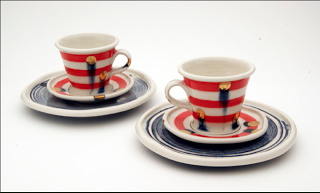 |
| Cups and Saucers by Sean O’Connell |
in their own marketing strategies. It turned my eyes and ears sharply
toward how contracts between galleries and artists are approached. It
began an investigation. The relevance of the topic was underscored on a
recent episode of Tales of a Red Clay Rambler in the discussion between Host Benjamin Carter and guest Sean O’Connell.
O’Connell opined the current gallery/artist relationship model seems
good for no one, but he was not yet sure what the alternative was.
reading this post, then I feel it is safe to assume you are familiar
with the field of ceramics. I feel it is safe to assume you are
familiar with the marketing success of Ayumi Horie’s model. We all stand in awe of her professional prowess and clever marketing strategies. Have you seen that match striker video?
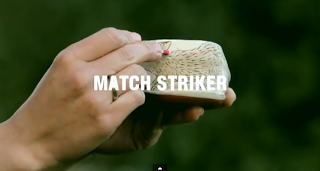 |
| Auymi Horie’s Match Striker |
as the Ceramic Artist of the Year, as much for the high quality of his
studio objects, as for his success in establishing a production line of
tiles featured in the Home & Garden section of the January 2013 issue of the New York Times.
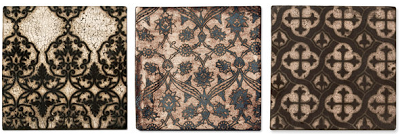 |
| Forrest Lesch-Middleton’s Tiles |
I am assuming we are all familiar with these success stories, I don’t
want to focus on them. Mainly, I will not address the models of the
aforementioned artists because their success puts them into the realm of
“other” and may seem out of reach to artists who are in the throes of
development and question. Rather, I have talked to and listened to
artists who are at the brink of their own concepts.
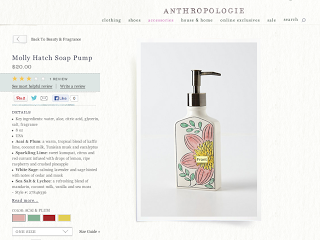 |
| Molly Hatch’s Ware on Anthropologie |
stated in his feature when asked about what advice he would give to
those aspiring to make a living in ceramics he acknowledged the practice
of, “…revisiting [familiar but easily forgotten advice] on a daily
basis.”
that I have arrived at a solution, or an entirely new model for the
gallery/artist relationship, but in the interest of continuing to,
“…provide a place for professionally minded ceramic artists to develop,”
I have a clarified picture of a galleries responsibility and role in
the equation.
addicted to Tales of a Red Clay Rambler? I kind of am, and I don’t find
it to be too much to work in ceramics, listen to other ceramic makers,
and then head to the office to coordinate ceramic exhibitions. Rather, I
tend to languish in the muddy water, submerged in the many
conversations. It was a chat with Arrowmont’s Bill Griffith on the podcast that directed my attention to the new endeavor Objective Clay,
a collective of fourteen ceramic artists conceived during Utilitarian
Clay VI. Because I am blessed to reside in a region densely populated
by ceramic artists, an organic conversation with founding member Sunshine Cobb was
fairly easy to coordinate. I presented the question to Cobb, sharing
the conversation broadcast between O’Connell and Carter, and asked for
her perspective. Did she think that Objective Clay was the answer to artists taking the reigns on their own behalf and cutting out the need for galleries in our modern age?
still in its infancy and the members were in an ongoing conversation to
line out the manifestations of their objectives. Their mission
statement asserts they have, “…a
shared vision to create an artist established and maintained online
space. This space functions as a gallery to view our latest work as
well as a window into our current thoughts in process. By sharing our
ideas and opening our studios, we invite artists, non-artists,
educators, and students to actively engage in our artistic practices. In
this virtual studio, the people who love pots can view/purchase new
work and form direct relationships with the artists who make them.”
forming direct relationships is really the key to branding isn’t it? If
one wants to be successful in any endeavor, it all comes down the
relationships one establishes. The more circles one can overlap, the
more relationships are built and the end result is fiscal
success. Focusing on relationships, whether that relationships starts
with a one-on-one consultation with a jean’s designer or whether that
relationship starts by finding out what your favorite ceramic artist is
reading for inspiration on the Objective Clay bookshelf, allows
makers to maintain integrity in their marketing. By putting
relationships first, clients are able to step inside the creative
process and feel a part of it. Happily the end result can be a
successful bottom-line because clients are as invested in the final
product as the maker.
establish new relationships, Cobb reported that Objective Clay is
looking to corporate markets for sales in an effort to land wholesale
orders from clients with larger budgets. This year at the Wisconsin
NCECA keep an eye out for their partnership with restaurant chains
within the city. How great would it be to one day walk into a high-end
establishment and see the fare presented on hand-made wares? This kind
of vision is looking to the ever-narrowing space between design and
craft and grabbing a foothold. It isn’t an entirely new idea, but one
worth revisiting. It is a vision that looks beyond the tried and true,
and perhaps oversaturated market of contemporary ceramics.
 |
| Works by Sunshine Cobb Featured on Objective Clay |
the walls of Red Lodge Clay Center we are reviewing how we spread our
advertising dollars. The bulk of our budget targets the converted
within the pages of Ceramics Monthly. While we don’t want to step away
from a loyal base, we do want to consider how we can break into other
realms by looking to foodie magazines and events, as well as design
firms who might share the work of our artists with their clients. A
successful model to study is Red Dot.
founded on the idea of taking design into new markets by focusing on
the highest quality work and awarding it. New clients are constantly
coming to Red Dot so their presentations, homes, and companies might be
on the cutting edge of aesthetics and function.
wisdom from my discussion with Cobb was an anecdote about the standard
shipping arrangement between galleries and artists. Cobb is currently
working as a resident at the Archie Bray Foundation in Helena,
Montana. Shipping from Montana can be pretty pricey, and anyone who has
had to fly out of Montana to anywhere besides Seattle, Denver, or
Minneapolis can tell you there is no easy road out in regard to
travel. She shipped work to a gallery and made the choice to send a
grouping of smaller objects. Of course, all the work sold out rather
quickly and the gallery called to request she send more work for the
exhibition and include larger pieces in the next shipment. Cobb was
happy to oblige, but observed and asserted that she was getting the
short end of the deal in regard to the shipping arrangement. “If all of
my work sells, then the gallery never has to ship work back to
me.” Cobb suggested the gallery front the shipping costs on the next
shipment.
As a gallery
representative, I know that shipping costs are one of the larger line
items in our budget. While that cost is shared by our clients who pay
shipping and handling in their purchases, a gallery does maintain a
healthy stock of bubble wrap, peanuts, newsprint, boxes, tape, fragile
stickers, branding logo stamps, and includes supporting documents about
the artists and exhibitions in every package. Still, Cobb’s point was
taken. How can a gallery work to better reward its best
sellers? Especially if the intention of a gallery is to support the
livelihood of its artists as well as keeping the doors open. Hmmmm? Again,
the words from O’Connell’s Red Clay Rambler interview came back to me,
“…good for no one.” Cobb’s proposal didn’t seem at all unrealistic to
me: invest more in the artists who present proven product.
month I will present the rest of the story in my visits with Meredith
Host who divides her efforts between her commercial line Folded Pigs and
her studio output Dot Dot Dash, Meg Roberts
who has been busily building her socially motivated brand and soon to
be 501c3, Plants for Patients, by looking to the advocates for
reproductive rights, Andrea Moon who is building the new web format
Pedestal as a market place for contemporary craft, and tying the opening
model of custom denim back to the work of Andrew Gilliatt his
evolving concepts. We’ve seen the beginnings of the importance of
diversification and integrity and will delve more into those areas, as
well as being reminded of the importance of perseverance and planning. Until then, my thanks to Carole Epp and the Musing about Mud blog for providing a venue and an audience for this discussion.

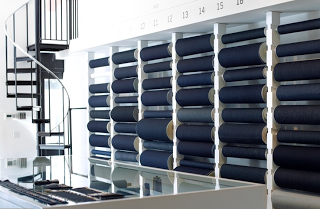
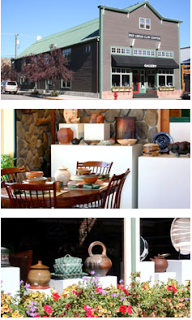
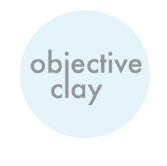

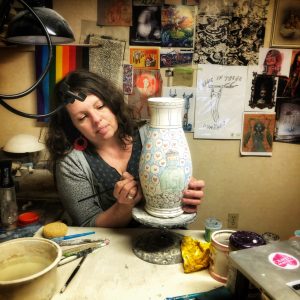
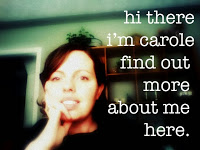
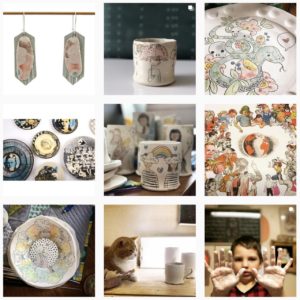
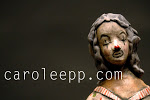
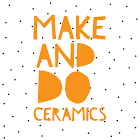

Be careful of the slippery slope!
While it does seem justified that artists who are guaranteed sellers not have to pay excessive shipping for some of their larger pieces, by making exceptions for these artists you are saying that not everyone represented there is treated equally. You pointed out that: "the core tenets of the mission statement, “…provide a place for professionally minded ceramic artists to develop…and share the importance of art in everyday life.” And that "When we invite an artist to be part of an exhibition or to be represented by our commercial gallery, we are asking said maker to buy in to that mission statement as well." But what it now sounds like is that some artists get preferential treatment and you are asking people to buy into that.
Maybe that's simply the way of the world, and galleries are more an organ of commerce than actual 'support for artists'. But if that's the case we should be more honest that the mission statement reflect the priority of its commercial successes. Nothing wrong with that, I suppose, but it only perpetuates the hierarchies and discriminations within the field. Plenty of professional minded artists will simply not qualify for the 'kickbacks', and rather than actual honest good work and professionalism being rewarded we reward the celebrity of the star system.
As a business, that may make sense. The bureaucracy tends to look out for its own interests, and that means it needs to take care of the goose that lays the golden egg. But as so often in the business world, where exactly does that leave the small fry? Neglected and prejudiced against, most often. The inequities are often startling. And its not always their fault for being disadvantaged. The system is set up to reward the heavy hitters.
And so, we need to ask whether we are comfortable being part of an elitism that fails to treat all art of reasonable quality equally. If that's the case then the mission statement needs to read something along the lines of "provide a place where established professionals can develop". And there may be nothing wrong with that attitude. But once you start to discriminate on some basis its usually not just one preferential outcome but a cascade of slights and prejudices that get leveled against the unfortunate.
Again, I'm not saying it needs to be one way or the other. Its just worth thinking through the consequences of making these decisions. Thanks for at least raising this discussion. Its clearly something we need to talk about.
Hey Carter-
Great point, my only concern with your response is that you seem to have read that Red Lodge Clay Center has made a unilateral decision to reward best sellers. We haven't. I'm sorry if it sounded like we had. Everything I wrote is an ongoing conversation about questions we look at everyday. We don't always have an answer, but we are keeping an eye out for new ways to do what we do better and to continue supporting professionally minded ceramic artists who make quality work.
Thank you so much for your thoughtful response, it's a great counterpoint in the conversation. And, while we have thought a lot about equitable contracts, we haven't phrased the point quite like you just did. So, here's my question I would ask you. Would it really be so bad to reward folks if we continued to provide a national venue for less established artists who might have a difficult time getting their work included elsewhere? Doesn't continued fiscal success enable a commercial operation to reach down the ladder and help more because of the loyalty of the like minded "elite"? And, I suspect we probably would get myriad responses if we tried to define "elite". Some of our best sellers probably don't consider themselves elite.
I'm interested in hearing your reply and thanks again! -Jill
Hi Jill,
Thanks for your response and for taking the scenario a step further! That's an interesting question! Of course I think every artist appreciates the efforts in making space for shows that include the less established professionals in the field. Or at least I hope they do (Not many will have 'made it' without at least some beneficent hands-up). And of course galleries don't get to do that if they are not making fiscal ends meet, which I suppose happens primarily through the efforts directed at the artists who ARE established. So it makes sense to support their interests as coinciding with those of the gallery.
But when it gets phrased as "Doesn't continued fiscal success enable a commercial operation to reach down the ladder and help more because of the loyalty of the like minded "elite"?" it ends up sounding an awful lot like the Trickle Down Theory of Economics. When you consider offering preferential shipping policies to the established artists it sounds an awful lot like 'tax breaks for the rich'. When its a question of "How can a gallery work to better reward its best sellers?" I'm sure you can see that it looks like we are aiming at more 'tax breaks' for those at the top of the ladder….. Incentivising contracts to lure the top sellers may just be good business practice. But if we are prepared to treat some artists differently we can see where this might end up going. Discrimination never seems as blatant until you are on the receiving end.
Of course I am relieved that this is not actual policy but part of an ongoing conversation! And since this discussion seems to have much in common with political issues, wouldn't it be interesting to suggest 'tax relief' for 'the poor'? Give THEM the shipping discounts? Not just occasionally reaching down the ladder in a paternalistic offering of a solid meal instead of crumbs, but actual institutional support for the 'Have Nots'. (An art Welfare system?)
Its a tricky issue for sure! And galleries may not be the place to ask that question. Its hard to argue that we should "reward failure" or that we should "penalize success", but sharing the burden for the continued survival of our field and its institutions has to be spread somehow. Who can afford it and who can least afford it? A tricky question. If we are not going to treat everyone as equal, that everyone pays the same, pays their own way, at least that equality is justice of a sort.
But maybe it evens out. Maybe the occasional hand-outs for the 'poor' balance out with the tax-breaks for the 'rich'. I'm not the one to offer an opinion on that. I just know what it looks like to me. You ask "Would it really be so bad to reward folks if we continued to provide a national venue for less established artists who might have a difficult time getting their work included elsewhere?" And obviously the hand-up to less established artists is a positive. The question is whether we can only do that not as a mission, not as a matter of policy, not as a simple matter of equity, but only as the result of further preferential 'rewarding' of the folks already eating high up on the food chain.
Its an interesting question!
Thanks for the discussion! And thanks for bringing these issues to the light of public inspection. Its fascinating to hear what gets considered in the decision making of our field.
All the best!
Carter
Sorry to belabor the point, but this just crossed my inbox. Its from the Createquity blog, which is one of the leading arts advocacy blogs. Here's what it has to say:
"The arts labor market has been called one of the oldest examples of a “winner-take-all” economy, a term popularized by Robert Frank and Philip Cook in their 1995 book, The Winner-Take-All Society: Why the Few at the Top Get So Much More Than the Rest of Us. The hallmark of this kind of market is extreme income inequality, whereby a small number of the bright, talented, and fortunate generate the majority of economic value. Case in point: according to the New York Times, 56 percent of all concert revenue in 2003 flowed to just a handful of pop music stars like Justin Timberlake and Christina Aguilera. That left less than half the year’s proceeds to be divided amongst all other performers.
(….)
Many of those artists, just like Andrew Carmichael Post and his classmates, will likely have difficulty repaying their student loans. In “Artists in the Winner-Take-All Economy,” sociologist Mark Stern surmises that income disparity in the arts is representative of overall trends in our society, and we ignore it at our own peril. He also paints a rather pessimistic picture of an economy that perpetuates the culture of superstars ad infinitum once it takes hold. The outcome is a country wholly divided by income and accessibility, a depressing thought. However, if the arts are in any way representative of the rest of the system, then working to transform its micro-economy into a healthier and sustainable one may provide clues as to how to pull our society out of the superstar spiral." http://createquity.com/2013/10/artists-not-alone-in-steep-climb-to-the-top.html
Hey Carter-
I've spent the weekend turning this over, hoping for some epiphany. The best I've come up with is something I think you alluded to on the other side of the coin. Is the trickle down model balanced on the other side by the model of a welfare program for those who are grinding it out, making work that is equally strong, but somehow they missed the luck boat of the spotlight? Right now the best we can do is keep talking about it and operate equally. I agree there is justice in that equality. Can't you feel we are on the brink of change though? Maybe we will have to come up with another word for "gallery", or perhaps the definition will change as the model does. The second part of this article illustrates folks who are working to redefine what success in contemporary craft looks like. It always does come down to individuals and individual choices and luck, let's not forget luck. Part of my motivation in pursuing the conversation in a public format is a reaction to the several polls, posts, and memes of late which suggest the field of craft is the worst career decision a person can make. I think those predictions are true if we continue to move forward with the same models, but there are so many folks redefining their marketing strategies, trying to figure out a way to work smarter. In the course of any paradigm shift there are going to be sacrificial lambs who help turn the tide. Let's hope we manage to hang on to our souls in the process.
This weekend I was in Cabela's and noticed several sales people who were (and I am about to grossly project my own life and perceptions, so you are forewarned) suffering from standing behind a retail counter all day. I perceived their body types to be the result of a mostly sedentary 40-hour work week when they would rather be in the field. What does that model look like? I quickly spin it into a socialist/communist regime, where corporations, in lieu of larger salaries, offer stakeholders living space, insurance, and a split of field work and counter work resulting in a happier(?) lifestyle. Lots of dangerous ramifications in that little scenario, but if we are afraid to walk up and examine slippery slopes and learn from them, how will we evolve? I think I would like to share a cup of coffee with you in person and brainstorm out some ideas. Short of that, I'm still excited about this precipice we are on and I know my own heart. I will do my best to continue placing myself on a team that moves us forward, looking at as many potential futures as possible, and I refuse to accept the sentence that a choice to work in the arts is a death sentence.
In regard to your most recent post, and on the topic of defining success, I think article is a little short-sighted. Success is about achieving a lifestyle, and while the Flaming Lips do not have the commercial success and worldwide recognition of Justin Bieber and his ilk, I believe they are living the life they want to live on their own terms. We can all have the brass ring if we have eyes to see how many brass rings have been abandoned on the ground out of blindness.
For anyone still interested in thinking about these issues there was a post in the New York Times today that talks about marketplace expectation that most artists, even well established ones, will give their work for free for the sake of exposure. I'm sure every artist can relate to this when they are asked to donate for eminently worthy causes. The problem is that the low opinion of artists seems to make them ideal candidates for getting taken advantage of. Something worth thinking about….
Here's the article and some quotes from it:
http://www.nytimes.com/2013/10/27/opinion/sunday/slaves-of-the-internet-unite.html?pagewanted=all&_r=1&
"A familiar figure in one’s 20s is the club owner or event promoter who explains to your band that they won’t be paying you in money, man, because you’re getting paid in the far more valuable currency of exposure. This same figure reappears over the years, like the devil, in different guises — with shorter hair, a better suit — as the editor of a Web site or magazine, dismissing the issue of payment as an irrelevant quibble and impressing upon you how many hits they get per day, how many eyeballs, what great exposure it’ll offer. “Artist Dies of Exposure” goes the rueful joke."
"The first time I ever heard the word “content” used in its current context, I understood that all my artist friends and I — henceforth, “content providers” — were essentially extinct. This contemptuous coinage is predicated on the assumption that it’s the delivery system that matters, relegating what used to be called “art” — writing, music, film, photography, illustration — to the status of filler, stuff to stick between banner ads."
"I know there’s no point in demanding that businesspeople pay artists for their work, any more than there is in politely asking stink bugs or rhinoviruses to quit it already. It’s their job to be rapacious and shameless. But they can get away with paying nothing only for the same reason so many sleazy guys keep trying to pick up women by insulting them: because it keeps working on someone. There is a bottomless supply of ambitious young artists in all media who believe the line about exposure, or who are simply so thrilled at the prospect of publication that they’re happy to do it free of charge."
"“Let us not kid ourselves,” Professor Vladimir Nabokov reminds us. “Let us remember that literature is of no practical value whatsoever. … ” But practical value isn’t the only kind of value. Ours is a mixed economy, with the gift economy of the arts existing (if not exactly flourishing) within the inhospitable conditions of a market economy, like the fragile black market in human decency that keeps civilization going despite the pitiless dictates of self-interest."